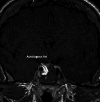Endoscopic transcavernous approach for functional pituitary adenomas
- PMID: 38890156
- PMCID: PMC11189304
- DOI: 10.1007/s00701-024-06168-x
Endoscopic transcavernous approach for functional pituitary adenomas
Abstract
Background: Invasion of the CS is one of the limiting factors for total resection for PitNet tumors with cure rates less than 30%. Extended approaches may be considered in selective and well-studied cases of secreting adenomas.
Method: We describe the key steps of the endoscopic transcavernous approach for functional pituitary adenomas with a video illustration. The surgical anatomy is described along with the advantages and limitations of this approach.
Conclusion: A detailed knowledge of CS anatomy and familiarity with this surgical approach acquired in the laboratory is essential. Proper instrumentation is critical to decrease the risks of vascular injury.
Keywords: Cavernous sinus; Endoscopic approach; PitNet; Pituitary adenomas.
© 2024. The Author(s).
Conflict of interest statement
All authors certify that they have no affiliations with or involvement in any organization or entity with any financial interest (such as honoraria; educational grants; participation in speakers’ bureaus; membership, employment, consultancies, stock ownership, or other equity interest; and expert testimony or patent-licensing arrangements), or non-financial interest (such as personal or professional relationships, affiliations, knowledge or beliefs) in the subject matter or materials discussed in this manuscript.
Figures



References
-
- Berhouma M, Messerer M, Jouanneau E (2012) Occam’s razor in minimally invasive pituitary surgery: tailoring the endoscopic endonasal uninostril trans-sphenoidal approach to sella turcica. Acta Neurochir (Wien) 154:2257–2265. 10.1007/s00701-012-1510-2 - PubMed
-
- Cossu G, Belouaer A, Kloeckner J, Caliman C, Agri F, Daniel RT, Gaudet JG, Papadakis GE, Messerer M (2023) The enhanced recovery after surgery protocol for the perioperative management of pituitary neuroendocrine tumors/pituitary adenomas. Neurosurg Focus 55:E9. 10.3171/2023.9.FOCUS23529 - PubMed
-
- de Macedo Filho LJM, Diogenes AVG, Barreto EG, Pahwa B, Samson SL, Chaichana K, Quinones-Hinojosa A, Almeida JP (2022) Endoscopic endonasal resection of the Medial Wall of the cavernous sinus and its impact on outcomes of pituitary surgery: a systematic review and Meta-analysis. Brain Sci 12. 10.3390/brainsci12101354 - PMC - PubMed
-
- Fernandez-Miranda JC, Zwagerman NT, Abhinav K, Lieber S, Wang EW, Snyderman CH, Gardner PA (2018) Cavernous sinus compartments from the endoscopic endonasal approach: anatomical considerations and surgical relevance to adenoma surgery. J Neurosurg 129:430–441. 10.3171/2017.2.JNS162214 - PubMed
Publication types
MeSH terms
LinkOut - more resources
Full Text Sources
Medical

